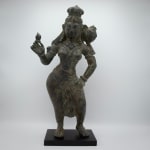Bronze Sculpture of the Goddess Lakshmi, c. 11th to 12th century CE
Bronze
height 40 cm
height 15 3/4 in
height 15 3/4 in
LI.1015
Further images
-
(View a larger image of thumbnail 1
)

-
(View a larger image of thumbnail 2
)

-
(View a larger image of thumbnail 3
)

-
(View a larger image of thumbnail 4
)

-
(View a larger image of thumbnail 5
)

-
(View a larger image of thumbnail 6
)

-
(View a larger image of thumbnail 7
)

-
(View a larger image of thumbnail 8
)

-
(View a larger image of thumbnail 9
)

-
(View a larger image of thumbnail 10
)

This beautiful statuette represents Shri Lakshmi, one of the three components of Tridevi, the Hindu trinity of goddesses. She is a principle aspect of the Mother Goddess, and is associated...
This beautiful statuette represents Shri Lakshmi, one of the three components of Tridevi, the Hindu trinity of goddesses. She is a principle aspect of the Mother Goddess, and is associated with wealth, fortune, love, beauty, joy, and prosperity. Shri Lakshmi is the consort and divine energy of the god Vishnu. Archaeological discoveries in former Hindu kingdoms ranging from India to Afghanistan, such as coins and reliefs, attest the worship of Sri Lakshmi already in the 1st millennium BCE.
The goddess is here represented standing, with her left leg gently forward. Her beautiful and tight-fitting dress is decorated with golden threads, symbolising fortune and wealth. Her connection to richness is also embodied in her elaborated jewellery: bracelets, cincture and several band over her breast. In her right hand she holds a highly decorated lotus flower, following her iconography as Padmahasta (she whose hand is holding a lotus). The lotus, a flower blossoming in clean or dirty water, symbolises purity regardless of circumstances, unaffected by surrounding evil. The flower is the main iconographical attribute of the goddess, and is referenced in many of her epithets and alternate names listed in numerous ancient Hindu texts: Kalamatmika (she of the lotus), Padmapriya (lover of the lotus), Padmamaladhara (she who is bearing a garland of lotuses).
The goddess is here represented standing, with her left leg gently forward. Her beautiful and tight-fitting dress is decorated with golden threads, symbolising fortune and wealth. Her connection to richness is also embodied in her elaborated jewellery: bracelets, cincture and several band over her breast. In her right hand she holds a highly decorated lotus flower, following her iconography as Padmahasta (she whose hand is holding a lotus). The lotus, a flower blossoming in clean or dirty water, symbolises purity regardless of circumstances, unaffected by surrounding evil. The flower is the main iconographical attribute of the goddess, and is referenced in many of her epithets and alternate names listed in numerous ancient Hindu texts: Kalamatmika (she of the lotus), Padmapriya (lover of the lotus), Padmamaladhara (she who is bearing a garland of lotuses).









